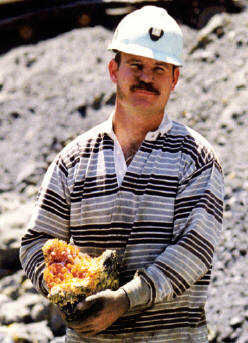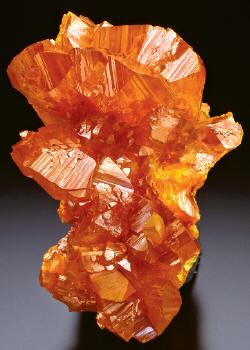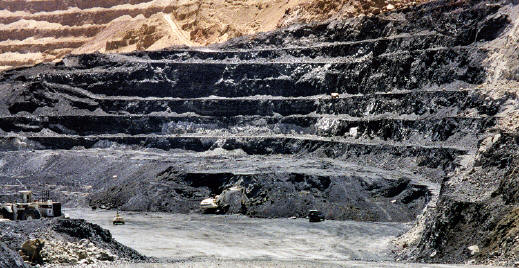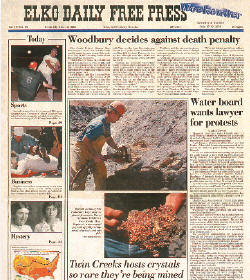Author: Scott KLEINE, Bryan K. LEES & Malcolm SOUTHWOOD Date: 2014-9-6 17:24:27
Orpiment is not a particularly raremineral. It occurs in many places in lowtemperature hydrothermal veins and inhot spring deposits but is rarely of specimenquality. However, when it occurs aswell-formed lustrous crystals it is highlyprized by collectors on account of itsstriking, honey-yellow to orange-browncoloration. Unfortunately, such specimensare difficult to extract withoutdamage because orpiment is soft, andthe crystals have perfect cleavage.

Graham Sutton of Collector’s Edge with freshly mined high quality orpiment specimen. Collector’s Edge photo.

Spectacular orpiment specimen from Cut 62 in Twin Creeks mine, Nevada, USA; 9.6 cm high. Azurite Corporation specimen. J. Scovil photo.
The discovery of well-crystallisedorpiment at the Twin Creeks minein Northern Nevada, USA, and it's subsequentextraction as fine mineral specimensprovides an almost
uniqueexample of co-operation between twocorporations; one of them the miningcompany that owns and operates themine, and the other a company that specializesin the recovery of specimenqualityminerals. Between 1999 and 2001more than 4000 specimens were recoveredby a dedicated team of professionals,through the patient and painstakingextraction of material using advancedmechanical equipment. Whole orpimentrichbodies were completely worked out and an enormous volume of specimenmaterial was saved from the crushers,including some of the world’s finest examplesof orpiment. Arguably, the TwinCreeks discovery was, and remains, the most important find for this attractivemineral species.

Map of North America with insert showing satellite photo of the Twin Creeks mine.

View of the Mega Pit of Twin Creeks mine showing location of 1999 Cut 62 orpiment find (arrow). Collector’s Edge photo.
LOCATION AND MINING HISTORY
The Twin Creeks gold mine is locatedroughly 72 km northeast of Winnemucca,and 16 km northeast of theGetchell gold mine, in the Potosi MiningDistrict, Humboldt County, Nevada, USA.
Massive blasting in Twin Creeks mine. Collector’s Edge photo.
Gold was discovered in the Twin Creeksarea in 1984 by Goldfields Mining Companygeologist Paul Tietz, and the depositwas originally named ChimneyCreek. This was followed by an additionaldiscovery, in 1987, in the samearea by the Santa Fe Pacific Gold Corporation,who named their deposit RabbitCreek. Even at this early stage orpimentveins, and even some free-growing crystals,were noted in some diamond drillcores!
View of Cut 62 during orpiment collecting operation, note heavy equipment. Collector’s Edge photo.
Initially these discoveries were developedas separate mining operations,but in 1993 the two companies mergedand consolidated the properties to formthe Twin Creeks mine. In 1997 NewmontMining Corporation acquired Santa Fe Pacific. Newmont was the owner of theTwin Creeks mine at the time of themajor orpiment discoveries and specimenrecovery operations, and remainsthe owner today.
In the late 1990s when the orpimentdiscoveries occurred, Twin Creeks minewas the third largest gold producer inNorth America and it comprised twoopen pits: the Vista pit,
exploiting oxideores, and the Mega pit, working sulfideore. At that time over 700 people wereworking there on a 24-hour, 7-day-perweekschedule. The Mega pit, at thattime, was about 1 km long with averagedaily ore production in excess of 40,000tons. Yearly gold production was about28,000 kg produced from over 15,000,000tons of ore!
Recent production has declinedsomewhat, but is still in the order of12,000 kg per year! Historic gold production productionand known future reserve atTwin Creeks total more than 600 tons ofcontained gold – enough to form a solidcube that is more than 3 meters on anedge!
Workings in orpiment rich zone in 1999. Collector’s Edge photo.
GENERAL GEOLOGYThe Twin Creeks area is underlainby sedimentary rocks of Palaeozoic agethat host auriferous mineralization characteristicof Carlin-type deposits. Theseare sediment-hosted, disseminated golddeposits, characterized by invisible (typicall ymicroscopic and/or dissolved) goldin pyrite and arsenopyrite. This type ofdeposit is named after the Carlin mine,which was first large deposit of this typediscovered in the Carlin Trend near Carlinin Eureka County, Nevada.
The Carlin type deposits show enrichmentin the elements gold, antimony,arsenic, mercury, thallium, and barium,created by circulation of hydrothermalfluids with a temperature of up to 300°C. The underlying rocks out of which theseelements are dissolved are normally siltycarbonates, although silicates and othersediments are also possible sourcerocks.










 YueGongAnBei 44051102000467
YueGongAnBei 44051102000467


 |
|